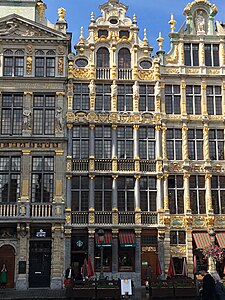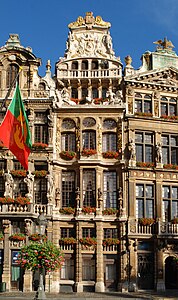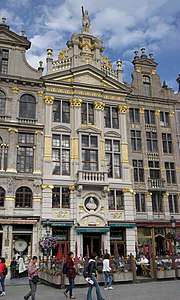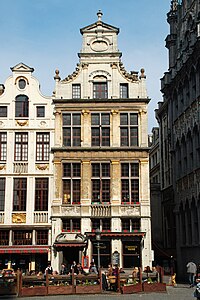Peter van Dievoet (/ˈdiːvʊt/; written in his native Dutch of the period as 'Peeter van Dievoet',[3] in French literature referred to as 'Pierre Van Dievoet', Latin: Petrus; 1661–1729) was a Flemish Baroque sculptor, statuary, wood carver and designer of ornamental architectural elements active in Brussels and England. He is known for his work on a number of the Baroque guild houses on the Grand-Place (Brussels' main square),[4] which was rebuilt after the bombardment of 1695, as well as on the Statue of James II on Trafalgar Square, London, made in collaboration with fellow Flemish sculptor Laurens van der Meulen.[5][6] He was the half-brother of Philippe van Dievoet, goldsmith to King Louis XIV of France and the uncle of the Parisian printer Guillaume Vandive.[7]
Peter van Dievoet | |
|---|---|
| Born | |
| Baptised | 29 June 1661 |
| Died | 2 March 1729 (68 years old) Brussels |
| Nationality | (1661–1714) : Spanish Netherlands (1714–1729) : Austrian Netherlands |
| Known for | Sculpture, architecture |
| Notable work | Statue of James II, Trafalgar Square and facades of buildings on the Grand-Place, |
| Style | Baroque,[1] classical[2] |
| Spouse | Dorothea de Witte |
| Elected | Guilds of Brussels, Drapery Court, Magistracy of Brussels. |
Life
Early years
Peter van Dievoet was born in Brussels as the son of Gillis van Dievoet (? - † before 1672), a burgher of Brussels, and Gertrudis Zeevaert. He was baptised at the Church of St. Michael and St. Gudula (now Brussels' cathedral) on 29 June 1661.[8] His father was previously married to Catarina Slachmeulder (or Catharina Slachmoelders), whose son Philippe van Dievoet later became a goldsmith to King Louis XIV of France.[9] The young Peter became fatherless around the age of twelve or thirteen. His mother later remarried and died on 22 July 1705.


Residence in London (1680–1688)
He moved at some unknown date to England where he was a collaborator in the studio of (Rotterdam-born) English sculptor Grinling Gibbons from 1680 to 1688. Gibbons was mainly known as a sculptor for his fine carvings of floral motifs. Other experienced Flemish sculptors such as Artus Quellinus III (the son of Artus Quellinus II), John Nost, Anthony Verhuke and Laurens van der Meulen also worked in Gibbon's London workshop as "servants", i.e. collaborators. As these Flemish artists were not trainees they were never entered in the Draper's records.[14]
Van Dievoet's English production (mainly sculptures) remains relatively unknown. In the Gibbons workshop he worked on various commissions but the contributions of the various artists active in the workshop are not always identifiable.[15] George Vertue mentions van Dievoet only as statuary.[16]
George Vertue found an agreement and a payment receipt for the bronze statue of James II (1686) made for the courtyard of Whitehall and currently placed on Trafalgar Square. Vertue attributed this work to a collaboration between van Dievoet and a certain Laurens of Mechelen.[5] Margaret Whinney notes that this statue does not have an English but rather a continental character and gives it the same attribution: "two Flemings, Laurens of Mechelen and Dievot of Brussels (sic), were employed to model and make it."[17] This attribution is repeated by Sir Lionel Henri Cust: "Dyvoet (sic) ... and Laurens ... who executed the statue of James II at Whitehall."[18] The aforementioned Laurens was identified by Paul-Eugène Claessens as the Flemish sculptor Laurens van der Meulen from Mechelen.[19]
Some studies for statues of probably Charles II or James II held in the British Museum are attributed to van Dievoet.[11][12][20]
A bronze statuette of James II in the collection of the V&A, previously attributed only to Artus Quellinus III, has had its attribution changed in 2023 to possibly being by the hand of van Dievoet.[21]
Return to Brussels (1689–1729)

He returned to Brussels as a result of the events arising from the Glorious Revolution of 1688, which had led to the deposition of the English King.[5] In 1695, he became master of the Quatre-Couronnés at Brussels, the guild of stonemasons and sculptors. It is from this time that his work in Brussels begins. That same year, Brussels was largely destroyed by the French bombardment, which offered many opportunities for architects and sculptors in the rebuilding of the city. He was involved in the reconstruction of the Grand-Place in a Baroque style.[22]
Public functions
Van Dievoet occupied various public offices. From 1713 to 1723, between ages 52 and 62, he was one of The Eight and then Dean (judge) of the Drapery Court,[22] a Brussels institution comparable to a chamber of commerce, whose members were called the "brothers of the Guild". At the end of his term, he became a member of the magistrate as a Councilor of the City of Brussels from 1723 to 1724.[23] After that, he left public life. A pious man, he had been, until the end of his life, a marguillier (churchwarden) of the Church of St. Michael and St. Gudula.
He died in Brussels on 2 March 1729, at the age of 68.
Work
General

Long after van Dievoet's death, a report of the magistrates of Brussels to Prince Charles Alexander of Lorraine, Governor of the Habsburg Netherlands, dated 27 September 1771, quotes van Dievoet in a list of "very remarkable Brussels sculptors".[24] From his Brussels work, only the pieces mentioned by Guillaume Des Marez are known.[25] He is mainly known there for his design and execution of many of the guild houses of Brussels' Grand-Place.
The following works are described by Des Marez:[25]
The House of the White Lamb
The sculptures on the facade of the 1696 built House of the White Lamb (Maison de l'Agneau Blanc) on the Rue du Marché aux Herbes/Grasmarkt are the work of van Dievoet.
The Grand-Place
Van Dievoet sculpted the facades of the following guild halls on the Grand-Place: La Maison du Sac (Grand-Place, number 4), La Maison du Cornet (number 6), La Maison de l'Arbre d'Or or the House of Brewers (number 10), La Maison de la Chaloupe d'Or (number 24-25).[25] He was also the architect for Le Heaume (number 34).[25]
- La Maison du Sac
- La Maison du Cornet
- L'Arbre d'Or
- La Maison de la Chaloupe d'Or
- La Maison du Heaume
Wood carving
To van Dievoet are attributed some finely chiseled woodcarvings, such as the elaborate lime-wood ornamentation of festoons and fruits in the collection of the Royal Museums of Art and History of Brussels.[26] He also carved wooden "keerses" - richly decorated emblems that were used for celebrations of the tailors' guild of Brussels.[25]
Arms
 |
|
- Peter van Dievoet's arms from roll of arms of the Drapery Court of Brussels
- Van Dievoet's arms are featured on this roll of arms of the members of the Drapery Court of Brussels.
See also

Notes and references
Further reading
- — « La généalogie et l'héraldique au service de l'histoire de l'art », in L'Intermédiaire des généalogistes, n° 137, Brussels, 1968.
- — « Généalogie de Brou (x) », in L'Intermédiaire des généalogistes, n° 122, Brussels, 1966, p. 88.
- — La Grand'Place de Bruxelles, illustrations de Van Gucht, Brussels, galerie Ex-Libris, s.d., n° 10.
- Philippe Baert, Mémoires sur les sculpteurs et architectes des Pays-Bas, edited by Baron de Reiffenberg, Brussels, 1848, p. 117.
- Bénézit, Dictionnaire critique et documentaire des peintres, sculpteurs, dessinateurs et graveurs, Paris, 1955, vol. 3, p. 268 et ibid. Paris, 1956, vol. 4, p. 238.
- Bénézit, Dictionary of Artists, 2006, vol.4, p. 911.
- Edwin Beresford Chancellor, The Romance of Soho. Being an Account of the District, Its Past Distinguished Inhabitants, 1931, p. 32.
- David Blayney Brown, Catalogue of the Collection of Drawings in the Ashmolean Museum, Ashmolean Museum - Art, 1982, p. 637.
- Andrée Brunard, "La Grand-Place, joyau de la Capitale", in, Les Belles Heures de Bruxelles, Paris-Bruxelles, 1952, p. 170.
- J. E. Buschman, Annales de l'Académie d'archéologie de Belgique, Bruxelles, 1867, p. 486 et p. 507.
- Paul-Eugène Claessens et Julien Cuypers, "Quand Bruxelles ravagée renaît plus belle sous les ailes de l'archange : le sculpteur Pierre van Dievoet, son œuvre et sa famille", in Intermédiaire des généalogistes, no. 121, Brussels, 1966, pp. 39–41.
- Maurice Culot, Eric Hennaut, Marie Demanet, Caroline Mierop, Le bombardement de Bruxelles par Louis XIV et la reconstruction qui s'en suivit 1695-1700, Brussels, 1992, p. 218 (Contrat d'adjudication de la maison du Cornet, Grand-Place)
- Allan Cunningham, The Lives of the Most Eminent British Painters and Sculptors, vol III, New York, 1835, p. 14.
- Sir Lionel Henri Cust, "Grinling Gibbons", Dictionary of National Biography, London, 1949–56, vol. VII, p. 1140.
- M. J. De Decker, "Relevé de l'Agneau Blanc", (deuxième prix partagé, S.C.A.B. concours annuel de relevés de 1924), dans, L'Émulation, Brussels, 1925, plate 8.
- Guillaume Des Marez, Guide illustré de Bruxelles, Brussels, 1928, vol. 1, pp. 65, 81, 82, 89, 90, 92, 112, and vol. 11, p. 182.
- Guillaume Des Marez, "Les transformations de la ville de Bruxelles au XVIIème siècle et les métiers de la construction", Études inédites, Brussels, 1936, p. 135.
- Pieter D'Hondt, L'académie royale, notice historique, Brussels, s.d., p. 21.
- George Godwin, John Britton, The Churches of London: A History and Description of the Ecclesiastical Edifices of the Metropolis, 1839.
- David Green, Grinling Gibbons his work as carver and statuary, 1648-1721, Londres, 1964, pp. 56, 194.
- Great men of Great Britain, Cyclopaedia, Great Britain, 1866, p. 109.
- Rupert Gunnis, Dictionary of British Sculptors 1660–1851, London, 1953, pp. 130, 169, 406.
- Alexandre Henne et Alphonse Wauters, Histoire de la ville de Bruxelles, Bruxelles, 1845, vol. II, p. 556 ; Mina Martens, Index général, Brussels, 1972, s.v. "Dievoet".
- Mary Botham Howitt, Howitt's Journal of Literature and Popular Progress, William Howitt, 1847, p. 408.
- Johannes Immerzeel, De levens en werken der Hollandsche en Vlaamsche kunstschilders, beeldhouvers, graveurs, Amsterdam, 1842, p. 278.
- John Ingamells, Later Stuart Portraits 1685-1714. London: National Portrait Gallery, 2009, pp. 130, 387.
- Chevalier Edmond Marchal, Mémoire sur la Sculpture aux Pays-Bas pendant les XVII et XVIII siècles, Brussels, 1877, pp. 3, 12, 82, 190; La sculpture et les chefs-d'œuvre de l'orfèvrerie belges, Brussels, 1895, pp. 468, 5S3, 743.
- Dr. Kurt Zoege von Manteuffel, "Dievoet (Dievot), van Bildhauer in Brüssel", in Ulrich Thieme and Felix Becker (eds.), Allgemeines Lexicon des bildenden Künstler von der Antike bis zur gegenwart, Leipzig, 1913, vol. IX, p. 279.
- Victor-Gaston Martiny, "Le décor architectural de la Grand-Place", La Grand-Place de Bruxelles, Brussels and Liège, 1966, p. 122.
- André Monteyne, De Brusselaars in een stad die anders is, 1981, pp. 127, 367.
- Dr. Georg Kaspar Nagler, Neues Allgemeines Künstler- Lexicon, Munich, 1836, vol. III, p. 404.
- Henry-Charles van Parys, "Van Dievoet : réponse", L'Intermédiaire des généalogistes, no. 148, Brussels, 1970, p. 254.
- Alexandre Pinchart, Archives des arts, sciences et lettres, documents inédits, Gand, 1860, vol. I, p. 40.
- L. G. G. Ramsey, The Concise Encyclopedia of Antiques, The Connoisseur, London, 1901, p. 155.
- Viviane Roothooft, De Grote Markt te Brussel, Bruxelles, 1978, p. 13.
- Georges Sion, Bruxelles ou les contes de Mille et un ans, Bruxelles, 1979, pp. 170 et 174.
- Félix Stappaerts, "Pierre van Dievoet", Biographie Nationale de Belgique, Brussels, 1878, vol. VI, column 74; Brussels, 1936–1938, vol. XXVI, column 385.
- H. Avray Tipping, Grinling Gibbons and the Wood-work of his age (1648-1720), London, 1914, pp. 95, 125, 251.
- Alain Van Dievoet, "Les Vandive, consuls de Paris", L'Intermédiaire des généalogistes, no. 180, Brussels, 1975, pp. 452 à 453.
- Alain Van Dievoet, Une famille d'orfèvres et consuls de Paris d'origine bruxelloise : les van Dievoet dits van Dive, Bruxelles, 1976, passim (xérocopié).
- Alain Van Dievoet, "Question sur le sculpteur Pierre van Dievoet", L'Intermédiaire des généalogistes, no. 147, Brussels, 1970, p. 185.
- Alain Van Dievoet, "Un disciple belge de Grinling Gibbons, le sculpteur Pierre van Dievoet (1661-1729) et son œuvre à Londres et Bruxelles", Le Folklore brabançon, March 1980, no. 225, pp. 65-91.
- Alain Van Dievoet, "Généalogie de la famille van Dievoet originaire de Bruxelles, dite van Dive à Paris", Le Parchemin, Brussels, 1986, no. 245, pp. 273-293.
- Alain Van Dievoet, "Quand le savoir-faire des orfèvres bruxellois brillait à Versailles", Cahiers bruxellois, Brussels, 2004, pp. 19-66.
- Marcel Vanhamme, Bruxelles. Promenades dans le Passé, Brussels, 1949, pp. 76, 84.
- Louis Verniers, Un millénaire d'histoire de Bruxelles depuis les origines jusqu'en 1830, Brussels, 1965, pp. 364, 366, 644.
- George Vertue, Note Books, ed. Walpole Society, Oxford, 1930–47, vol. I, pp. 61, 82, 106; vol. IV, p. 50.
- George Vertue and Horace Walpole, Anecdotes of Painting in England, London, 1765, vol. III, p. 91.
- Alphonse Wauters, Liste des doyens des corps de métier de Bruxelles 1696-1795, Brussels, 1888, p. 55.
- Margaret Whinney, Sculpture in Britain, 1530 to 1830, London, 1964, p. 55.
- Dr. Alfred von Wurzbach, Niederländischer Künstler-Lexicon, Vienna and Leipzig, 1906, vol. I, p. 407.
External links
 Media related to Peter van Dievoet at Wikimedia Commons
Media related to Peter van Dievoet at Wikimedia Commons







